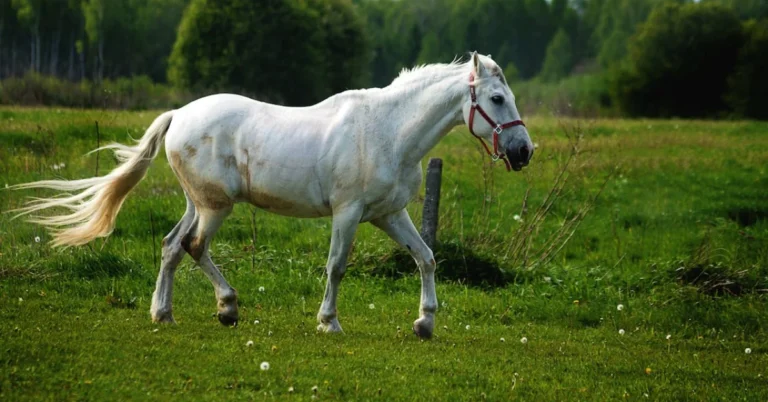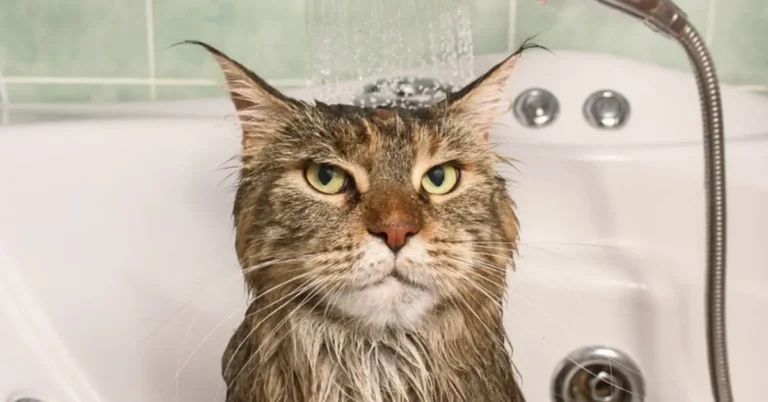Dwarf rainbowfish are absolutely captivating freshwater fish that have recently surged in popularity in the aquarium hobby. Their diminutive size, stunning iridescent colors, and energetic schooling behaviors make them a delight to observe. This comprehensive guide provides fishkeepers with everything needed to successfully care for these vibrant little fish and unlock their full beauty and personality in the home aquarium.
An Introduction to Dwarf Rainbowfish
Dwarf rainbowfish belong to the family Melanotaeniidae and originate from freshwater habitats across New Guinea, Australia, and Indonesia. There are over 30 recognized species, with many yet to be officially described.
Most dwarf rainbowfish species max out at 2 inches in length, with some remaining under an inch. This makes them well-suited for small nano aquariums, although most thrive best in a minimum 10 gallon tank.
The most popular and readily available dwarf rainbowfish species in the trade include:
- Neon Dwarf Rainbowfish (Melanotaenia praecox)
- Boeseman’s Rainbowfish (Melanotaenia boesemani)
- Spotted Blue-Eye Rainbowfish (Pseudomugil signifer)
- Celebes Rainbowfish (Marosatherina ladigesi)
- Dwarf Neon Rainbowfish (Melanotaenia uniformly)
Dwarf rainbows are recognized for their bright iridescent colors and flashy displays. Wild specimens often exhibit more subdued silver, brown, and olive coloration compared to the spectacular varieties bred in captivity. Selective breeding programs have created stunning strains with neon reds, electric blues, and vivid yellows.
In addition to their small size and vibrant colors, dwarf rainbowfish are generally peaceful, hardy, and adaptable to a wide range of water parameters. This makes them suitable for beginners as well as advanced aquarists looking to add pops of living color to their community tanks.
Natural Habitat and Origin
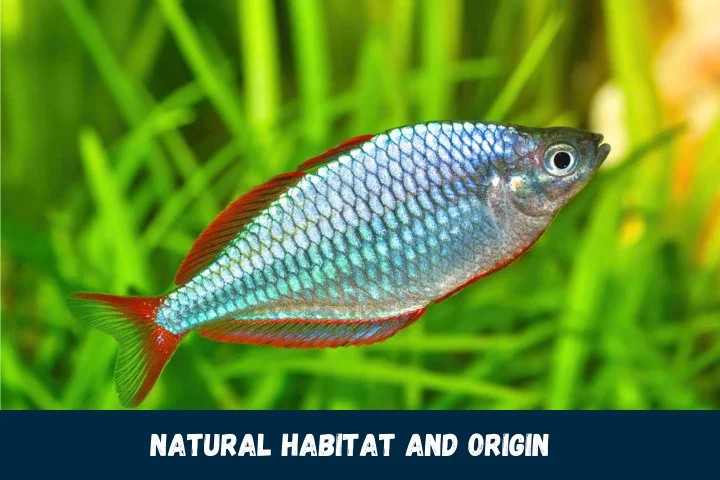
To create an ideal home aquarium environment, it’s important to understand the natural habitat of dwarf rainbowfish. Most species inhabit slow moving, vegetated freshwater streams, lakes, and ponds in tropical regions of New Guinea, Australia, Indonesia and surrounding islands.
Water parameters are generally soft and acidic in their native waters, with temperatures staying relatively warm year-round between 75-82°F. Aquatic plants are abundant, providing cover and foraging sites. The substrate is typically fine sand or gravel.
Dwarf rainbows reside alongside other small, peaceful fish species including other rainbowfish, ricefish, danios, rasboras, gobies, and more. Insects, crustaceans, and other microorganisms make up their natural diet.
Their bright colors likely evolved to help spot one another amidst dense vegetation. Males use visual displays to attract females and show dominance. By replicating critical elements of their natural environment in home aquariums, dwarf rainbowfish can thrive in captivity.
Housing and Tank Setup
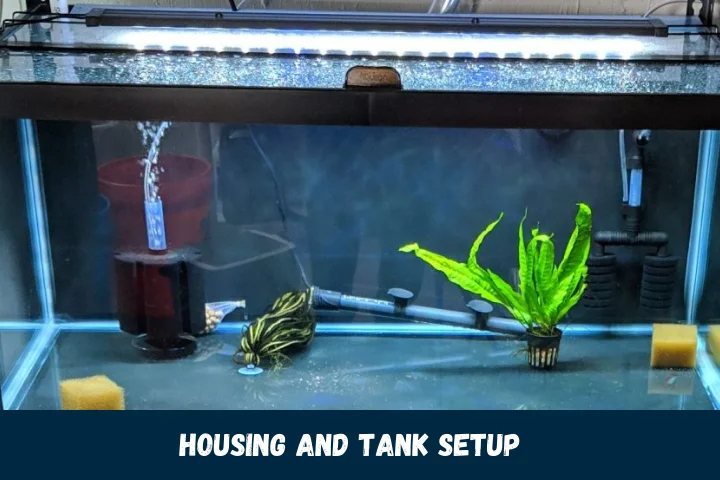
Proper tank setup goes a long way in keeping dwarf rainbows healthy and allowing their colors and behaviors to shine. Use these guidelines when preparing their living space:
Tank Size
- Minimum 10 gallons for a small shoal
- 20 gallon or larger strongly recommended
- Long tank better than tall; provide swimming room
Water Parameters
- Temperature: 75-82°F
- pH: 6.0-7.5
- Hardness: Soft to moderately hard
Filtration
- Canister filter or hang-on-back filter rated for tank size
- Moderate water movement; avoid very strong currents
Substrate
- Fine sand or smooth gravel
- Natural color like tan, black, or white
- 1-2 inches deep
Decorations and Plants
- Driftwood, rocks, cave structures
- Dense planting recommended; provide hiding spots
- Floating plants, mosses, stem plants, carpeting plants
Lighting
- Full spectrum LED or fluorescent lighting
- 6-8 hours per day
- Timer can simulate seasonal changes
Key Takeaways: Heavily planted tanks with soft, acidic water, smooth substrate, moderate current, and plenty of swimming space optimized for dwarf rainbowfish.
Suitable Tank Mates

Dwarf rainbowfish are peaceful community fish that should be housed with similarly sized tank mates. Good options include:
- Other rainbowfish
- Small rasboras
- Tetras
- Endler’s livebearers
- Dwarf cichlids
- Hatchetfish
- Otocinclus catfish
- Kuhli loaches
- Snails like nerites
Avoid housing dwarf rainbows with aggressive species prone to fin nipping like tiger barbs, bettas, or cichlids. Slow moving tank mates like shrimp may get eaten.
To minimize aggression, keep dwarfs in larger shoals of 6-10 fish. Offer plenty of plants, rocks, driftwood to create line of sight breaks and establish territories.
Key Takeaways: Stick to peaceful fish around the same size as dwarf rainbows. Heavily planted tanks and larger shoals promote harmony.
Feeding Dwarf Rainbowfish

Dwarf rainbowfish are omnivorous and eagerly accept a wide variety of foods in captivity. Offer a balanced, varied diet to bring out their best colors and keep them in top health.
Diet Staples
- Quality flake foods
- Micro pellet foods
- Frozen foods like brine shrimp, daphnia, cyclops
- Live foods: microworms, grindal worms
Supplemental Foods
- Freeze dried bloodworms, tubifex, krill
- Blanched vegetables: zucchini, spinach, cucumber
- Dried seaweed
- High quality dried foods
- Spirulina powder or flakes
Feeding Schedule
- Feed 2-3 small meals daily
- Variety is key; alternate different food items
- Only feed what fish can eat in 2-3 minutes
- Fast 1 day per week
By offering a rotating buffet of floating, sinking, and frozen foods, you can fulfill the nutritional needs of dwarf rainbowfish and bring out their brightest colors.
Rainbowfish Care and Maintenance
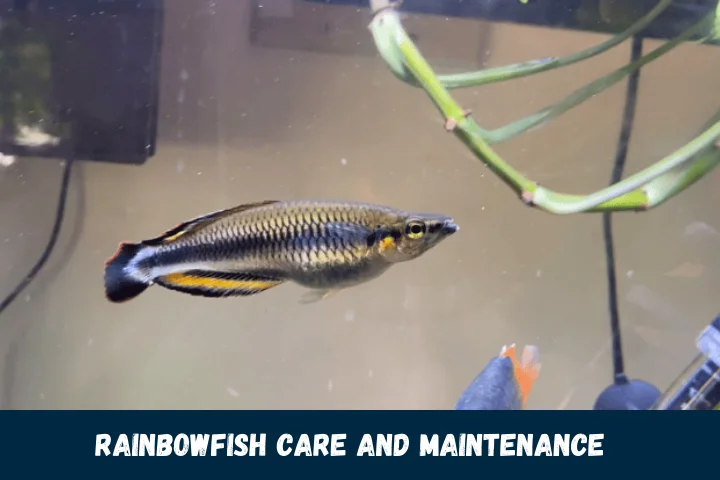
Caring for dwarf rainbowfish also involves maintaining proper water quality, performing routine tank maintenance, and keeping a look out for any potential health issues.
Water Changes
- 20-30% weekly, either partial or full
- Use gravel vacuum to remove waste
- Temperature and pH match aquarium water
Equipment Maintenance
- Clean/replace filter media monthly
- Wash decorations to remove algae buildup
- Prune plants to prevent overgrowth
- Clean protein film off glass
Monitoring Water Parameters
- Test for ammonia, nitrites, nitrates weekly
- pH, hardness, temperature daily at first
- Address any parameter deviations promptly
Quarantine Period
- 4-6 weeks recommended for new fish
- Allows observation for illness; prevent transmission
Algae Control
- Control light duration – 6-8 hours max
- Remove excess nutrients with water changes & filter media
- Clean glass and decor
- Use algae eaters like otos and snails
With close monitoring and routine maintenance, you can avoid many common fish health issues. Recognizing early disease signs and acting quickly improves outcomes as well.
Breeding Dwarf Rainbowfish
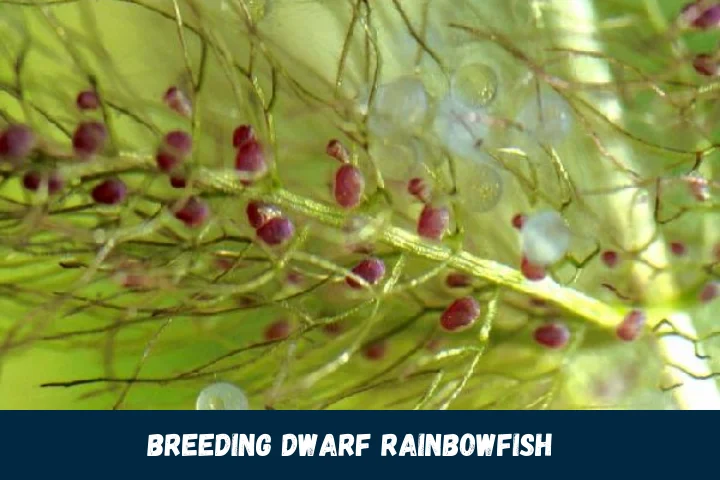
Many dwarf rainbowfish readily breed in home aquariums given proper conditions. It’s a rewarding challenge for the intermediate to advanced keeper. Here’s an overview of the dwarf rainbowfish breeding process:
- Use a 10-20 gallon breeding tank with fine substrate, plants like java moss or hairgrass, and a sponge filter.
- Select a breeding pair based on vibrant color and scale sheen. Some hormonal conditioning may be needed to initiate spawning mode.
- Perform large daily water changes using soft, acidic water. Lower the water level to 6 inches or so.
- Increase water temperature to 82-84°F. Feed high protein foods like live brine shrimp.
- The male will display to the female by extending his dorsal fin and intensifying his color. The pair will circle each other.
- The female will deposit eggs among the plants or substrate, which the male then fertilizes. They may spawn over the course of a few days.
- Remove adults after spawning is complete to prevent them from eating the eggs.
- Eggs hatch in 7-14 days. Feed newly hatched fry infusoria, then gradually offer finely crushed flake foods, microworms, or brine shrimp nauplii.
Avoid overcrowding the breeding tank. Perform frequent water testing and changes to keep the parameters pristine while the fry are growing out. In a few months they will reach maturity and display their full vibrant colors. Breeding dwarf rainbowfish takes some experience but brings tremendous rewards!
Common Dwarf Rainbowfish Diseases
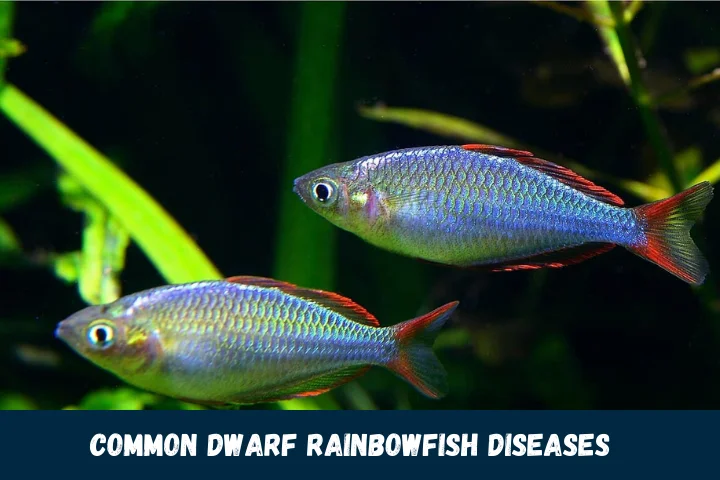
When maintained in a suitable environment, dwarf rainbowfish tend to be quite hardy and disease-resistant. But it’s still important to watch for any signs of illness and quickly address them. Here are some of the most common dwarf rainbowfish diseases:
Ich (White Spot Disease): Caused by the Ichthyophthirius multifiliis parasite. Fish will display small white grains resembling salt. Treat promptly with increased heat and aquarium salt or ich medication.
Fin Rot: Caused by bacteria opportunistically infecting the fins. Tattered, eroding fins with whitish edges. Usually triggered by poor water quality. Improve conditions and treat with antifungal or antibacterial fish medication.
Swim Bladder Disorder: Fish struggles to stay upright and float. Can result from physical injury, poor water quality, or improper diet. Feed peas to clear blockages and improve water parameters.
Bacterial Infections: Lethargy, clamped fins, reddened areas, fin/scale damage. Caused by poor conditions. Improve water quality and use broad spectrum antibacterial/antifungal medication.
Fungal Infections: White cottony growths on body, fins, mouth. Associated with unclean water, injuries, or stress. Use antifungal aquarium treatments. Improve tank conditions.
Catching and treating diseases promptly leads to much better outcomes for affected fish. Quarantine and observation periods for new fish can prevent transmission to existing tank inhabitants.
Interesting Rainbowfish Behaviors
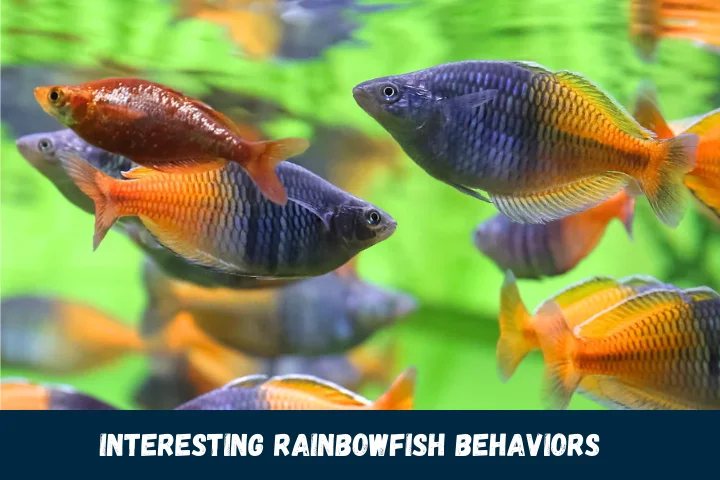
Beyond just their vibrant colors, dwarf rainbowfish display many fascinating behaviors when kept in optimal aquarium conditions.
- Schooling: They naturally congregate in groups, synchronizing their movements. Larger shoals exhibit better schooling behavior.
- Foraging: They eagerly pick at algae, biofilm and bottom debris. Provide sinking foods to trigger natural foraging instincts.
- Territory Display: Males flaunt their fins and intensify colors when displaying dominance or courting females.
- Bubble Nests: Male dwarf rainbows construct bubble nests from air bubbles during breeding displays.
- Shimmering: Their scales refract and reflect light, allowing neon colors to glisten and flash.
Make sure to spend time observing your rainbowfish shoal. You’re sure to catch glimpses of their natural, instinctive behaviors that reveal their intelligence and personalities.
Selecting Healthy Dwarf Rainbowfish
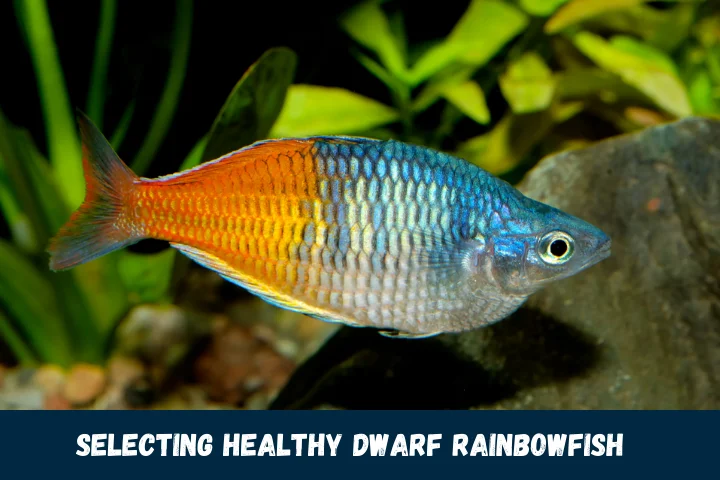
When shopping for dwarf rainbowfish, choose active specimens displaying bright, vivid colors. Here’s what to look for:
- Clear eyes without clouding or fuzziness
- Smooth skin and scales with good mucous layer
- Full finnage without any tears, erosion, or clamping
- Active swimming and alertness, eats readily
- Bright metallic sheen and intense colors
- Full, slightly rounded belly
- No abnormalities on body or fins
The color and condition of the overall tank can offer clues too. Avoid tanks with dead fish or uneaten food accumulating on the bottom. Tanks with vibrant, energetic, active fish signal an environment conducive to health.
While temptation exists to select fish showing drab colors at a discount, their muted appearance often indicates stress or illness. Healthy, active fish with coloring true to their species offer the best chance of thriving in your home aquarium.
Acclimating New Dwarf Rainbowfish
Introducing dwarf rainbowfish to a new tank environment requires a slow, careful acclimation process. Follow these steps:
- Dim aquarium lights to reduce stress. Turn off tank filtration/circulation.
- Float the unopened fish bag in the tank for 15 minutes to equalize temperatures.
- After floating, open the bag and roll down the sides, allowing the bag to fill with aquarium water. Let float another 15 minutes.
- Remove fish from the bag using a net or container.
- Discard bag water to avoid transferring pathogens or hormones.
- Place fish directly into the aquarium. Monitor closely, turning filtration/circulation back on.
- Disperse a small amount of tank water into the fish bag periodically during the float process to gradually acclimate them.
Rushing this process can shock the fish’s system. Take it slow. Observe the new fish closely following introduction. Allow a few weeks for full acclimation before introducing additional tankmates.
Spotlight on Popular Dwarf Rainbowfish Species
With over 30 species in the dwarf rainbowfish group, aquarists have diverse options. Here’s a spotlight on some of the most popular varieties found in the trade:
Neon Dwarf Rainbowfish

One of the smallest species, Melanotaenia praecox reach just 1.5 inches. Their neon red striping over an iridescent blue-green body makes them living jewels. Peaceful and active, they thrive in small shoals and nano tanks. Providing live foods helps intensify their colors.
Boeseman’s Rainbowfish
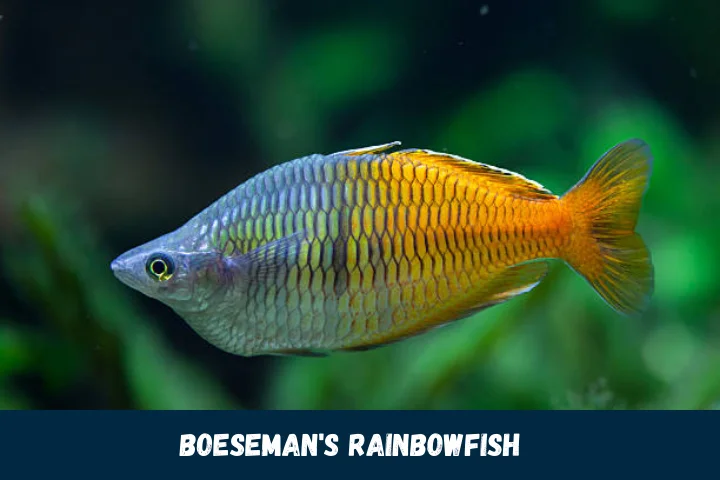
Melanotaenia boesemani stand out with their elongated dorsal fin and shimmering body stripes in hues of orange, blue, and silver. One of the larger dwarfs at 3 inches, they are perfect centerpiece fish. This bolder species may show some aggression toward smaller tank mates.
Celebes Rainbowfish
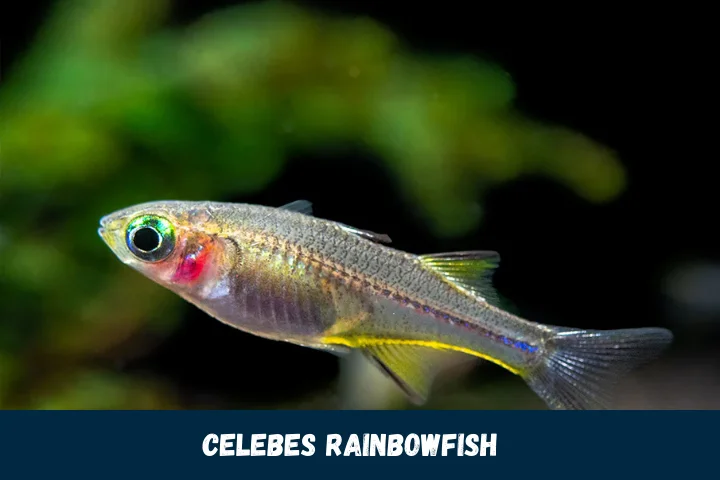
Among the most delicate dwarfs, Marosatherina ladigesi require strict water quality standards. Their pearlescent bodies shine with iridescent greens and hints of yellow. Peaceful but shy, they thrive in species specific planted tanks to truly exhibit their graceful beauty.
Conclusion
Dwarf rainbowfish offer aquarists the chance to bring a miniature world of color into their freshwater tanks. Their diversity, irresistible charm, and relatively manageable care make them suitable and rewarding for beginners and experienced keepers alike. By understanding their needs for ample swimming space, clean water, high quality foods, and appropriate tank mates, dwarf rainbowfish can thrive under captive care. Patient observation will reveal their delightful quirks and behaviors that showcase just how engaging these tiny fish can be. Become enchanted by their shimmering beauty, and you may just find yourself hooked on rainbows!


